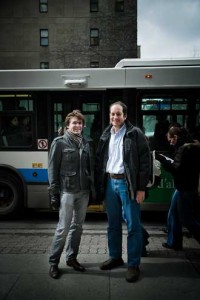
STM enlists help of McGill duo to speed up service
By Neale McDevitt
It’s the Murphy’s Law of public transit. You’re in a rush to make an appointment, you hop on a city bus and you spend the next 30 minutes on slow boil as the bus inches down the street, hitting each red light and grinding to a halt at every single stop to pick up passengers. Infuriated, you jump off and hail a cab, arriving at your destination 15 minutes late, and $15 lighter in your wallet.
As of March 30, riders of the 67 Saint-Michel bus route in the city’s east end have been breaking Murphy’s Law, thanks to the work of McGill Urban Planning professor Ahmed El-Geneidy and Urban Planning MA student Paul Tétreault.
Looking to streamline bus service along the 67 line, one of the cities busiest routes with some 40,000 passengers a day, the Société de transport de Montréal (STM) called on the McGill duo to help design a new limited-stop service called the 467 Express.
El-Geneidy and Tétreault pored over data collected by GPS systems and passenger counters installed on some of the buses (some 10 per cent of the STM bus fleet is equipped with such devices) to whittle the 40-stop route down to a mere 15 stops. “It is a trade off,” said Tétreault. “You want to serve as many people as possible, and get them as close as you can to their destination, but you want to make the service as efficient as possible too.”
While the normal 67 route has stops spaced approximately 400 metres apart, the 467 sees that gap extending to over a kilometer. The Express route runs at the same time as the regular route – a first for Montreal – giving passengers the option of speed or convenience.
On top of a more expedient service, the limited-stop route will also reduce the wear and tear on busses and the carbon footprint associated with stop-and-go driving.
“We estimate time savings in the order of 10 per cent,” said Tétreault. “The methodology we developed could be used to put in place other limited-stop routes on heavily used bus lines and improve transit
service.”
